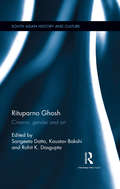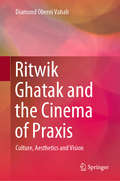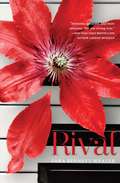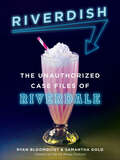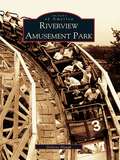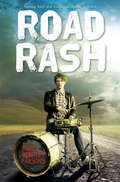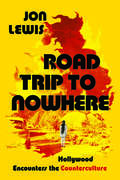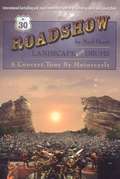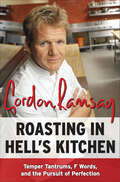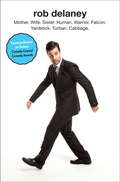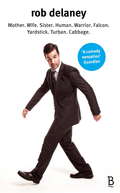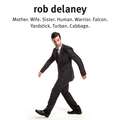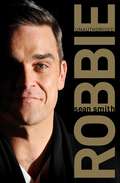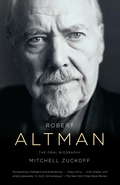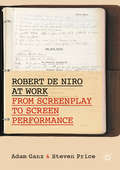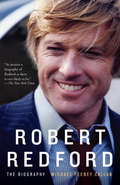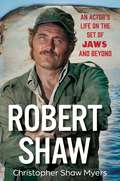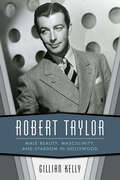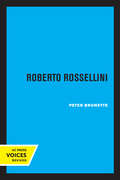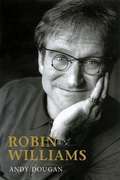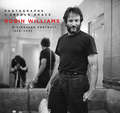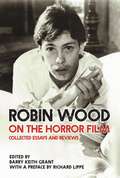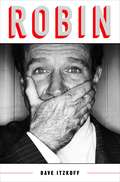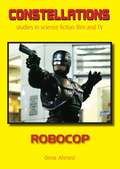- Table View
- List View
Rituparno Ghosh: Cinema, gender and art (South Asian History and Culture)
by Rohit K. Dasgupta Sangeeta Datta Kaustav BakshiAn iconic filmmaker and inheritor of the legendary Satyajit Ray’s legacy, Rituparno Ghosh was one of the finest auteurs to emerge out of contemporary Bengal. His films, though rooted firmly in middle-class values, desires and aspirations, are highly critical of hetero-patriarchal power structures. From the very outset, Ghosh displayed a strong feminist sensibility which later evolved into radical queer politics. This volume analyses his films, his craft, his stardom and his contribution to sexual identity politics. In this first scholarly study undertaken on Rituparno Ghosh, the essays discuss the cultural import of his work within the dynamics of a rapidly evolving film industry in Bengal and more largely the cinematic landscape of India. The anthology also contains a conversation section (interviews with the filmmaker and with industry cast and crew) drawing a critical and personal portrait of this remarkable filmmaker.
Ritwik Ghatak and the Cinema of Praxis: Culture, Aesthetics and Vision
by Diamond Oberoi VahaliIn a significant departure from other works on Ritwik Ghatak, this book establishes him as an auteur and a maestro on par with some of the great film directors, like Sergei Eisenstein, Satyajit Ray, Ingmar Bergman, Federico Fellini, Kenji Mizoguchi and Luis Bunuel. Based on in-depth research that follows Ghatak’s journey within the context of the Indian People’s Theatre Association, it fills an important gap in the scholarship around Ghatak by offering crucial insights into Ghatak’s unique vision of cinema embedded as it is in the cultural psychic configurations of the people. It analyses Ghatak’s practice by minutely tracing formal similarities across the language of his cinematic oeuvre in the domain of cinematography, lighting, music, and sound. The book develops the way in which cinematic technique enters the domain of conceptual constructs and abstractions. It moves on to chronicle Ghatak’s political odyssey as reflected in his cinema. Moreover, it charts the manner in which Ghatak, through his cinematic idiom, offers a polemic of cinema that further adds to his notion of praxis – a thoughtful Marxist paradigm organically associated with the culture and context of India. By locating Ghatak within the discourse of nationalism, the book brings to the surface Ghatak’s critical insights related to the independence of the nation and the trauma of the partition of Bengal. Ghatak’s cinema served the crucial function of chronicling the mass tragedy of partition and its impact on the human psyche.This book appeals to scholars of film studies and filmmaking as well as to researchers and general readers interested in debates pertaining to culture, politics, art, psychoanalysis, partition and refugee studies, cinema, theatre, and ideology.
Rival
by Sara Bennett WealerBrooke I don't like Kathryn Pease. I could pretend everything's fine between us. I could be nice to her face, then trash her behind her back. But I think it's better to be honest. I don't like Kathryn, and I'm not afraid to admit it. Kathryn I saw a commercial where singers used their voices to shatter glass, but the whole thing is pretty much a myth. The human voice isn't that strong. Human hatred is. Anybody who doubts that should feel the hate waves coming off of Brooke Dempsey. But I don't shatter; I'm not made of glass. Anyway, the parts that break aren't on the outside. Brooke and Kathryn used to be best friends . . . until the night when Brooke ruthlessly turned on Kathryn in front of everyone. Suddenly Kathryn was an outcast and Brooke was Queen B. Now, as they prepare to face off one last time, each girl must come to terms with the fact that the person she hates most might just be the best friend she ever had.
Riverdish: The Unauthorized Case Files of Riverdale
by Ryan Bloomquist Samantha GoldFrom the hosts of the Riverdish podcast, the unauthorized case files from the world of the CW’s teen drama sensation Riverdale.For Archie Andrews, Veronica Lodge, Jughead Jones, and Betty Cooper, high school is more than just pep rallies and milkshakes. Based on the beloved characters from the Archie Comics, Riverdale is a dark, addictive, campy teen thriller that devilishly mixes adolescent angst with corruption, politics, serial killers, gang wars, and twisted secrets. The emotional exploits of Archie, Veronica, Jughead, Betty, and their friends and foes have riveted fans across generations and catapulted the teen drama series into an iconic cultural phenomenon spawning internet discussion groups and podcasts. One such podcast is Riverdish, hosted by the adoring and enthusiastic Ryan and Sam, and they have taken it upon themselves to complete the complicated and necessary task of creating the essential unauthorized case files on Riverdale's twisted web of lies, crimes and mysteries.Featuring case files on Riverdale’s beloved ensemble cast of Archie, Veronica, Jughead, Betty and their friends and foes, Riverdish offers up comprehensive breakdowns of the many mysteries and crimes that plague the town of Riverdale, paired with laugh-out-loud commentary and photos from behind-the-scenes of the show. Tackling everything from The Black Hood to Jingle Jangle to the Southside Serpents to bogus FBI agents and everything and everyone in between, Riverdish is an insightful and hilarious sendup of the case files that the authorities should use to track the many twists and turns of the show. With a deep knowledge of and appreciation for the show and all that makes it iconic, Riverdish dissects and celebrates the dramatic and thrilling darkness of Riverdale.
Riverview Amusement Park (Images of America)
by Dolores HaughEvery summer from 1904 to 1967, for 63 years, Riverview--the world's largest amusement park--opened its gates to millions of people from all walks of life. For three generations, the Schmidt's family park offered rides, shows, food, and music to men, women, and especially children. Riverview survived depressions, two World Wars, labor disputes, Prohibition, and a World's Fair that threatened to take a great deal of its business. Riverview Amusement Park tells the story of Riverview's growth from 22 acres and three rides to 140 acres and more than 100 attractions. Through an extensive collection of never-before published images, author Dolores Haugh chronicles the tale of this impressive chapter of Chicago history. Known as the "Roller Coaster Capital of America," Riverview remained a Chicago landmark until it was unexpectedly closed in 1967.
Road Rash
by Mark Huntley ParsonsA teenage drummer finds out what life is really like on tour with a rock band in this funny, funky, bittersweet debut YA novel. For anyone who loved Almost Famous or This Is Spinal Tap.After being dropped from one band, 17-year-old drummer Zach gets a chance to go on tour with a much better band. It feels like sweet redemption, but this is one rocky road trip. . . . Zach's in control on the drums, driving the band, keeping things moving at the right pace. But when the show is over, his timing is all off. The jealousies and rivalries within his new group keep him off-balance. The awesome original song he recorded backfires. And the girl he left back home is suddenly talking about this other guy . . . Mark Parsons has written a fast-paced, feel-good novel about a boy finding his place in the world, in a band, and in the music. Zach is a character teens will stand up and cheer for as he lands the perfect gig, and the perfect girl. From the Hardcover edition.
Road Trip to Nowhere: Hollywood Encounters the Counterculture
by Jon LewisHow a new generation of counterculture talent changed the landscape of Hollywood, the film industry, and celebrity culture. By 1967, the commercial and political impact on Hollywood of the sixties counterculture had become impossible to ignore. The studios were in bad shape, still contending with a generation-long box office slump and struggling to get young people into the habit of going to the movies. Road Trip to Nowhere examines a ten-year span (from 1967 to 1976) rife with uneasy encounters between artists caught up in the counterculture and a corporate establishment still clinging to a studio system on the brink of collapse. Out of this tumultuous period many among the young and talented walked away from celebrity, turning down the best job Hollywood—and America—had on offer: movie star. Road Trip to Nowhere elaborates a primary-sourced history of movie production culture, examining the lives of a number of talented actors who got wrapped up in the politics and lifestyles of the counterculture. Thoroughly put off by celebrity culture, actors like Dennis Hopper, Christopher Jones, Jean Seberg, and others rejected the aspirational backstory and inevitable material trappings of success, much to the chagrin of the studios and directors who backed them. In Road Trip to Nowhere, film historian Jon Lewis details dramatic encounters on movie sets and in corporate boardrooms, on the job and on the streets, and in doing so offers an entertaining and rigorous historical account of an out-of-touch Hollywood establishment and the counterculture workforce they would never come to understand.
Roadshow, A Landscape With Drums
by Neil Peart"In this unique travelogue, Peart leverages his considerable literary penmanship to describe the joys and rigors of a rock tour as well as his impressions of the politics, social mores, and cultural heterogeneity he encounters across states and nations. As Peart travels for his art, he perfectly describes the art of travel."
Roasting in Hell's Kitchen: Temper Tantrums, F Words, and the Pursuit of Perfection
by Gordon RamsayEveryone thinks they know the real Gordon Ramsay: rude, loud, pathologically driven, stubborn as hellFor the first time, Ramsay tells the full inside story of his life and how he became the world's most famous and infamous chef: his difficult childhood, his brother's heroin addiction, his failed first career as a soccer player, his fanatical pursuit of gastronomic perfection and his TV persona—all of the things that made him the celebrated culinary talent and media powerhouse that he is today. In Roasting in Hell's Kitchen Ramsay talks frankly about his tough and emotional childhood, including his father's alcoholism and violence and their effect on his relationships with his mother and siblings. His rootless upbringing saw him moving from house to house and town to town followed by the authorities and debtors as his father lurched from one failed job to another. He recounts his short-circuited career as a soccer player, when he was signed by Scotland's premier club at the age of fifteen but then, just two years later, dropped out when injury dashed his hopes. Ramsay searched for another vocation and, much to his father's disgust, went into catering, which his father felt was meant for “poofs.”He trained under some of the most famous and talented chefs in Europe, working to exacting standards and under extreme conditions that would sometimes erupt in physical violence. But he thrived, with his exquisite palate, incredible vision and relentless work ethic. Dish by dish, restaurant by restaurant, he gradually built a Michelin-starred empire.A candid, eye-opening look into the extraordinary life and mind of an elite and unique restaurateur and chef, Roasting in Hell's Kitchen will change your perception not only of Gordon Ramsay but of the world of cuisine.
Rob Delaney: Mother. Wife. Sister. Human. Warrior. Falcon. Yardstick. Turban. Cabbage.
by Rob DelaneyWho is that hairy guy in the green Speedo? Rob Delaney is a father, a husband, a comedian, a writer. He is the author of an endless stream of beautiful, insane jokes on Twitter. He is sober. He is sometimes brave. He speaks French. He loves women with abundant pubic hair and saggy naturals. He has bungee jumped off of the Manhattan Bridge. He enjoys antagonizing political figures. He listens to metal while he works out. He likes to fart. He broke into an abandoned mental hospital with his mother. He played Sir Lancelot in Camelot. He has battled depression. He is funny as s***. He cleans up well. He is friends with Margaret Atwood. He is lucky to be alive. Read these hilarious and heartbreaking true stories and learn how Rob came to be the man he is today.Praise for Rob Delaney "A book as funny, sincere, weird, wet, and wonderful as Rob Delaney himself."--Jimmy Kimmel "Rob Delaney has done it again! Actually, this is his first book, so he has not 'done it again.' Actually, this book is so good, I doubt he will be able to do it again. He's peaked."--Judd Apatow"Rob's transition from tweets to book is like a gold medal sprinter winning the marathon the next day. I am jealous and angry."--Seth Meyers"WARNING: This book may cause involuntary seepage. Some funny, funny, funny, funny s*** from the most dangerous man on Twitter. The fact that he's just as funny in long form makes me want to vomit with envy."--Anthony Bourdain"All it takes to be as funny as Rob Delaney is luck, good timing, deep compassion, reckless imaginative agility, a flawless grasp of the inner workings of language, and criminally vast quantities of mojo. What a jerk."--Teju Cole, author of Open CityFrom the Hardcover edition.
Rob Delaney: Mother. Wife. Sister. Human. Warrior. Falcon. Yardstick. Turban. Cabbage.
by Rob DelaneyRob Delaney is a father, a husband, a comedian, a writer. He is the author of an endless stream of beautiful, insane jokes on Twitter. He is sober. He is sometimes brave. He speaks French. He has bungee-jumped off the Manhattan Bridge. He enjoys antagonizing political figures, powerful retailers and the Kardashians. He listens to metal while he works out. He broke into an abandoned mental hospital with his mother. He played Sir Lancelot in Camelot. He has battled depression. He is funny as s***. He cleans up well. He and Margaret Atwood have a thing going on Twitter. He is lucky to be alive.
Rob Delaney: Mother. Wife. Sister. Human. Warrior. Falcon. Yardstick. Turban. Cabbage.
by Rob DelaneyRob Delaney is a father, a husband, a comedian, a writer. He is the author of an endless stream of beautiful, insane jokes on Twitter. He is sober. He is sometimes brave. He speaks French. He has bungee-jumped off the Manhattan Bridge. He enjoys antagonizing political figures, powerful retailers and the Kardashians. He listens to metal while he works out. He broke into an abandoned mental hospital with his mother. He played Sir Lancelot in Camelot. He has battled depression. He is funny as s***. He cleans up well. He and Margaret Atwood have a thing going on Twitter. He is lucky to be alive.
Robbie
by Sean SmithRobert Peter Williams was a sixteen-year-old selling double glazing when he auditioned for a new boy band which became Take That. Twenty years later he is one of the most popular entertainers Britain has ever produced: he has recorded eight number one albums in the UK and he sold 1. 6 million tickets for his 2006 world tour in a day. The most successful artist in the history of The Brits, Robbie was given a Lifetime Achievement Award one day before his 36th birthday in 2010. The UK's leading celebrity biographer Sean Smith has followed Robbie's remarkable journey from the unpromising streets of Stoke-on-Trent to the millionaire's playground of Beverley Hills and discovered a vulnerable, funny, gifted and deeply complex man. Using new research and interviews, Sean Smith reveals there is far more to being Rob than just being Robbie Williams, superstar. Robbie's roller coaster story will astonish you. Sean Smith's heart-warming account of his life is the unmissable show business book of the year.
Robert Altman: The Oral Biography
by Mitchell ZuckoffThe late Robert Altman--visionary director, hard-partying hedonist, eccentric family man, Hollywood legend--comes roaring to life in this rollicking cinematic biography, told in a chorus of voices that can only be called Altmanesque.
Robert De Niro at Work: From Screenplay to Screen Performance (Palgrave Studies in Screenwriting)
by Steven Price Adam GanzRobert De Niro and the Working Screenplay is the first critical study to examine how Robert de Niro, perhaps the finest screen actor of his generation, works with screenplays to imagine, prepare and denote his performance. In categorising the various ways in which De Niro works with a screenplay, this book will re-examine the relationship between actor and text. This book considers the screenplay as above all a working document and a material object, present at every stage of the filmmaking process. The working screenplay goes through various iterations in development and exists in many versions on set, each adapted and personalised for the specific use of the individual and their role. As the archive reveals, nobody works more closely with the script than the actor, and no actor works more on a script than De Niro.
Robert Redford: The Biography
by Michael Feeney CallanThe long-anticipated biography of Robert Redford.Among the most widely admired Hollywood stars of his generation, Redford has appeared onstage and on-screen, in front of and behind the camera, earning Academy, Golden Globe, and a multitude of other awards and nominations for acting, directing, and producing, and for his contributions to the arts. His Sundance Film Festival transformed the world of filmmaking; his films defined a generation. America has come to know him as the Sundance Kid, Bob Woodward, Johnny Hooker, Jay Gatsby, and Roy Hobbs. But only now, with this revelatory biography, do we see the surprising and complex man beneath the Hollywood façade.From Redford's personal papers--journals, script notes, correspondence--and hundreds of hours of taped interviews, Michael Feeney Callan brings the legendary star into focus. Here is his scattered family background and restless childhood, his rocky start in acting, the death of his son, his star-making relationship with director Sydney Pollack, the creation of Sundance, his political activism, his artistic successes and failures, his friendships and romances. This is a candid, surprising portrait of a man whose iconic roles on-screen (Butch Cassidy and the Sundance Kid, All the President's Men, The Natural) and directorial brilliance (Ordinary People, Quiz Show) have both defined and obscured one of the most celebrated, and, until now, least understood, public figures of our time.From the Hardcover edition.
Robert Shaw: An Actor's Life on the Set of JAWS and Beyond
by Christopher Shaw MyersRobert Shaw, the iconic star of Steven Spielberg&’s Jaws, comes boisterously to life in an up-close-and-personal biography that reveals the brilliant actor, esteemed playwright, prize-winning novelist, and loving and hard-living family man as never before.Robert Shaw unforgettably commanded attention as the weathered seaman Captain Quint in the blockbuster sensation, Jaws. But what came before and after that landmark film is as dramatic as the hunt for the great white shark itself.Capturing the many facets of the vibrant, generous, and sometimes polarizing man is his nephew, Christopher, who explores the forces that shaped a dynamic personality—including Robert&’s indomitable mother, his deeply troubled father, and his activist sister, Joanna, with whom Robert shared an unbreakable bond. Out of the traumatic events of their childhood in the Orkney Islands and Cornwall, Mrs. Shaw pushed her children to pursue their dreams. For Robert, that dream was acting and writing.Despite a storied career on the British and American stage—as both performer and playwright—and a string of hit films including From Russia with Love, A Man for All Seasons, The Sting, and The Taking of Pelham One Two Three, international celebrity eluded Robert . . . until he was summoned to star in &“a little horror film&” called Jaws.What happened on-screen was unforgettable. What happened off-screen was chaos. Now Christopher Shaw Myers reveals the true story of the making of the classic. Jaws would become both an artistic success and a worldwide triumph for Robert Shaw. Tragically, for a man shadowed by his father&’s demons, it would also signal the beginning of the end.Drawing on family recollections, personal letters, scrapbooks, recordings, extensive interviews, and a lifetime of his own memories, Christopher paints a unique, intimate, and honest portrait of a man he was proud to call his uncle.
Robert Taylor: Male Beauty, Masculinity, and Stardom in Hollywood
by Gillian KellyBecause of his lengthy screen resume that includes almost eighty appearances in such movies as Camille and Waterloo Bridge, as well as a marriage and divorce to actress Barbara Stanwyck, Robert Taylor was a central figure of Hollywood’s classical era. Despite this, he can be regarded as a “lost” star, an interesting contradiction given the continued success he enjoyed during his lifetime. In Robert Taylor: Male Beauty, Masculinity, and Stardom in Hollywood, author Gillian Kelly investigates the initial construction and subsequent developments of Taylor's star persona across his thirty-five-year career. By examining concepts of male beauty, men as object of the erotic gaze, white American masculinity, and the unusual longevity of a career initially based on looks, Kelly highlights how gender, masculinity, and male stars and the ageing process affected Taylor's career. Placing Taylor within the histories of both Hollywood’s classical era and mid-twentieth-century America, this study positions him firmly within the wider industrial, cultural, and socioeconomic contexts in which he worked. Kelly examines Taylor’s film and television work as well as ephemeral material, such as fan magazines, to assess how his on- and off-screen personas were created and developed over time. Taking a mostly chronological approach, Kelly places Taylor’s persona within specific historical moments in order to show the complex paradox of his image remaining consistently recognizable while also shifting seamlessly within the Hollywood industry. Furthermore, she explores Taylor’s importance to Hollywood cinema by demonstrating how a star persona like his can “fit” so well, and for so long, that it almost becomes invisible and, eventually, almost forgotten.
Roberto Rossellini
by Peter BrunetteThis is the first full-length study in any language of the most significant film director of Italian Neorealism. Peter Brunette combines close analyses of Roberto Rossellini's formal and narrative style with a thorough account of his position in the political and cultural landscape of postwar Italy. More than forty films are explored, including Open City, Paisan, Voyage to Italy, The Rise to Power of Louis XIV, and films made in the director's later years that documented crucial epochs in human history. Brunette's book is based on eight years of research, during which he interviewed members of the director's family as well as Rossellini himself. Brunette also draws on an enormous body of European and American criticism and discusses the various intellectual debates spawned by the director's work. This landmark study is both a comprehensive introduction to one of the most influential practitioners of the contemporary cinema and a boldly original discussion of Italian Neorealism. This title is part of UC Press's Voices Revived program, which commemorates University of California Press's mission to seek out and cultivate the brightest minds and give them voice, reach, and impact. Drawing on a backlist dating to 1893, Voices Revived makes high-quality, peer-reviewed scholarship accessible once again using print-on-demand technology. This title was originally published in 1996.
Robin Williams
by Andy DouganThis book contains profanity and some descriptions of medical consequences of sexual encounters. Scottish author Andy Dougan holds Robin Williams in high esteem as he demonstrates in this unauthorized biography of one of America's best loved comedians. Through his interviews with Robin Williams, interviews with his friends and colleagues and extensive quotes of interviews Mr. Williams has given to Playboy and People magazines, nearly half of this biography is in Williams' own words. Beginning with the first manifestations of the humor the lonely only child used to exchange with his often absent mother, to the humor that deflected bullies at school, to the humor he used to ease the tension in his acting classes at Julliard to the humor that won the heart of America in Mork and Mindy and Good Morning Vietnam, Dougan traces Williams development from a self absorbed loner to a manic, substance abusing, womanizing actor/comedian who was too insecure to listen to the silence. Dougan traces Robin Williams's growing maturity through his first serious romance, through his first marriage where he was at the same time needy and unfaithful, to his second marriage where he had come to treasure family life. Williams set out to be a serious actor, but it was his irrepressible, spontaneous, train of thought and associative humor which captured the attention of professionals and public alike in stand-up comedy clubs and on television. Williams has made many films, often choosing challenging roles rather than parts sure to break records at the box office. In this biography you will make the journey with him through desperate depression and addiction, failed projects and disappointments to the films which have made him proud and showcased his talent as a comedian as in Mrs. Doubtfire and his serious acting abilities in Awakenings, and his ability to entertain children like his own in Aladdin. The pages are full of Hollywood background material and trivia and the author's pleasant style, fair minded approach and forward momentum will hold any reader's interest. The extensive filmography, list of Williams' top ten grossing movies at the box office, list of sources by chapter and complete index are included and have been carefully checked.
Robin Williams: A Singular Portrait, 1986-2002
by Arthur GraceI had always thought that when I was around 84 and Robin was 80 we could collaborate on a book about the golden years of his career where he could look at my photographs and reminisce about the events and his feelings at the time. Unfortunately, that book was never to be . . . .Photographer Arthur Grace first met Robin Williams in April 1986, at a comedy club in Pittsburgh where Williams was working to polish what would eventually become his award-winning special "Evening at the Met". The two hit it off immediately, and thus blossomed a close friendship that carried them through their increasingly successful careers. Told through a series of stunning photographs of Williams taken by Grace over the course of this decades-long partnership, Robin Williams: A Singular Portrait offers a touching and up-close look at the real Robin Williams-the manic and happy, the pensive and weary, the engaged and disengaged, a true portrait of one of America's greatest comics and most beloved actors.For the millions of people around the globe that Robin Williams has touched, these images, more than 150 photographs, a glorious mixture of stunning color and resonating black and white presented in exhibit format, will be something to embrace and cherish, not simply because of their exclusivity, but because of their intimacy and their honesty.
Robin Wood on the Horror Film: Collected Essays and Reviews (Contemporary Approaches to Film and Media Series)
by Barry Keith Grant Robin Wood Richard LippeRobin Wood—one of the foremost critics of cinema—has laid the groundwork for anyone writing about the horror film in the last half-century. Wood’s interest in horror spanned his entire career and was a form of popular cinema to which he devoted unwavering attention. Robin Wood on the Horror Film: Collected Essays and Reviews compiles over fifty years of his groundbreaking critiques. In September 1979, Wood and Richard Lippe programmed an extensive series of horror films for the Toronto International Film Festival and edited a companion piece: The American Nightmare: Essays on the Horror Film — the first serious collection of critical writing on the horror genre. Robin Wood on the Horror Film now contains all of Wood’s writings from The American Nightmare and nearly everything else he wrote over the years on horror—published in a range of journals and magazines—gathered together for the first time. It begins with the first essay Wood ever published, "Psychoanalysis of Psycho," which appeared in 1960 and already anticipated many of the ideas explored later in his touchstone book, Hitchcock’s Films. The volume ends, fittingly, with, "What Lies Beneath?," written almost five decades later, an essay in which Wood reflects on the state of the horror film and criticism since the genre’s renaissance in the 1970s. Wood’s prose is eloquent, lucid, and convincing as he brings together his parallel interests in genre, authorship, and ideology. Deftly combining Marxist, Freudian, and feminist theory, Wood’s prolonged attention to classic and contemporary horror films explains much about the genre’s meanings and cultural functions. Robin Wood on the Horror Film will be an essential addition to the library of anyone interested in horror, science fiction, and film genre.
Robin's Guide to Being Cool (LEGO Batman Movie)
by Meredith Rusu<p>Tweet-tweet on the street! Are you ready to join a crime-fighting team, defeat the greatest enemies of all-time, and become the coolest super-hero sidekick there is? If you answered "yes," then this is the guide for you! Discover your inner cool with help from Robin(TM), the coolest super-hero sidekick in the universe. This guide features full-color images from the hit LEGO(R) Batman Movie(TM) and everything you need to know about becoming a super-hero sidekick from Robin himself. Now we're hip, now we're movin'--come on Bat-fans, let's get groovin'! <p>This is a fixed-format ebook, which preserves the design and layout of the original print book.</p>
Robin: The Definitive Biography of Robin Williams
by Dave Itzkoff<p>From his rapid-fire stand-up comedy riffs to his breakout role in Mork & Mindy and his Academy Award-winning performance in Good Will Hunting, Robin Williams was a singularly innovative and beloved entertainer. He often came across as a man possessed, holding forth on culture and politics while mixing in personal revelations – all with mercurial, tongue-twisting intensity as he inhabited and shed one character after another with lightning speed. <p>But as Dave Itzkoff shows in this revelatory biography, Williams’s comic brilliance masked a deep well of conflicting emotions and self-doubt, which he drew upon in his comedy and in celebrated films like Dead Poets Society; Good Morning, Vietnam; The Fisher King; Aladdin; and Mrs Doubtfire, where he showcased his limitless gift for improvisation to bring to life a wide range of characters. And in Good Will Hunting he gave an intense and controlled performance that revealed the true range of his talent. <p><i>Robin</i> by Dave Itzkoff shows how Williams struggled mightily with addiction and depression – topics he discussed openly while performing and during interviews – and with a debilitating condition at the end of his life that affected him in ways his fans never knew. Drawing on more than a hundred original interviews with family, friends and colleagues, as well as extensive archival research, <i>Robin</i> is a fresh and original look at a man whose work touched so many lives.</p>
RoboCop (Constellations)
by Omar AhmedRoboCop was Dutch director Paul Verhoeven's first American film, and was both a commercial and (surprise) critical hit on release in 1987. Marking its thirtieth anniversary, this volume explores the film from a variety of critical approaches, including re-reading RoboCop as a Western; the neo-fascist corporatization of the human body; satire, late-Reagan America and the rise of neo-liberalism; resurrection, death, and the figure of the cyborg in science fiction; and the legacy of the film across American cinema and within Verhoeven's own body of work, which includes Total Recall and Starship Troopers, both of which develop further ideological interests about American culture. "I'd buy that for a dollar!"
